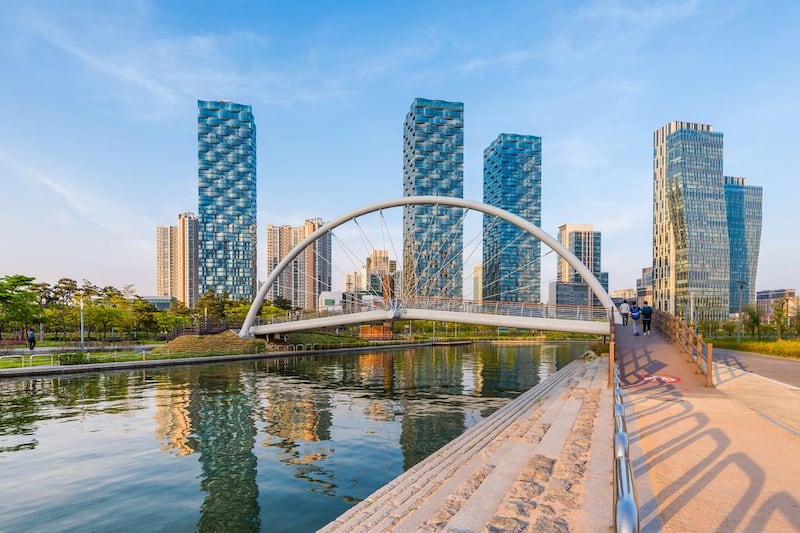The idea for my book was born out of my desire to tell the story of building smart cities from the perspective of a corporate entrepreneur. An idea and value proposition developed and incubated by a small team in Saudi Arabia and Dubai in 2005-06 has since swept the globe and become a large industry, setting the standard for a better, more sustainable urban future. There are many across the Middle East, Asia, China, and the Americas to whom I am indebted for making this story possible. As I look back now at my experience during a time of unprecedented human and technological progress across a part of the world that emerged and continues to emerge at breathtaking speed, I am struck by just how many incredible people I have worked with. To them, the real heroes of this story, I have dedicated my book.
The excerpt below focuses on Songdo, South Korea – a smart city built from the ground up on land south of Seoul and near Incheon airport.
The excerpt:
South Korea had made remarkable progress as a regional economy since the war-ravaged decades in the middle of the 20th century. By 2006, its GDP was among the top 15 in the world; brands such as LG and Samsung had established global profiles, and manufacturing had become a national juggernaut. When the financial crisis of 2008 hit, the Koreans felt the shock but stabilised quickly through a combination of stimulus and smart monetary policy.
Nonetheless, the country needed to adopt a new strategy to maintain its position and relevance. Its neighbours Japan and China supplied relentless economic pressure. The Koreans had relied on manufacturing for their gains, but that formula would no longer create success in a world that rewarded information and service providers. The Koreans realised they would have to fight to distinguish themselves from those same neighbours. With the flow of information and growth of corporations erasing national borders, Korea needed both a reason why multinationals should come and incentives to keep them there, spending and investing.
Geography alone was a selling point. Most of the cities in Japan, China, and southern Asia were along short flight paths from Seoul. Of course, Korea’s two primary economic rivals were also neighbours. Promoted in the right way, Korea could become a hub, the launching pad from which the expanses of the other Asian Tigers could be accessed.
If South Korea could not realistically keep apace of China, which had more than 20 times its population, perhaps it could exploit its position as a midrange power: deal maker, haven for foreign corporations, all while remaining a technology leader.
To attract foreign direct investment (FDI), South Korea launched a plan to develop new free economic zones. The Incheon Free Economic Zone (IFEZ), a development rolled out in 2003 that was still in its technological infancy, was among the first on the continent and perhaps the most essential of nine planned within the country. Regulations would be loosened for multinational anchor tenants, who would also find a nation with the world’s highest bandwidth penetration per capita (it retained that ranking as of 2014) and internet connectivity speed far above the global average. These factors were essential technology enablers, the foundation for the last element, which was to build a new city made to run on information.
Cisco was brought in on a consulting contract focused on a technological business park in Songdo’s International Business Distrcit (IBD). The Silicon Valley heavyweight Cisco’s contribution to the Songdo IBD experiment was to converge all city systems and services on a single network. The company had the opportunity to apply its trademark infrastructure to a services-led, smart city model.
Cisco fits the smart city bill
The concept of a smart and connected city was so new that even innovative companies such as KT and LG were hard-pressed to develop practical applications and service-orientated infrastructure.
This was why Songdo needed a plumber who understood and was able to design smart city services that addressed real urban needs and functionality. It also needed another source of investment capital. Cisco met both criteria.
Cisco’s vision for implementing the Internet of Everything at the root of a city would become the most important product in their inventory. At this stage, the team held out hope that one size would fit all, and that a single network infrastructure could underpin the dozens of cities slated for building in Asia and emerging markets in the next few decades. The company’s investment also lent legitimacy to the government’s efforts to create an economic powerhouse and travel hub; this, hopefully, would contribute to increased FDI and a virtuous cycle of foreign engagement.
Songdo was to be a prototype for sustainable urban life, an example of how a city could reduce its carbon footprint and resource usage in a world with ever-increasing population and climate-related problems.
Serious planners do not use the word “utopia.” In a 21st-century context, however, the ideal city experience would seamlessly mix and support business and high living standards, while providing ample green spaces and cutting the carbon footprint down to a manageable size. Some of the most excitable commentators could not resist outlandish projections of an ideal life for citizens and businesses in Songdo. That, of course, created both great expectations and scepticism. The city builders could hardly complain, since Songdo’s great promise was highlighted in a great deal of promotional material.
As opposed to brownfield smart and connected projects, which endeavour to tear down silos to integrate services, Songdo was to be silo-free from the outset. Every building, every function relevant to citizens and business tenants, would connect to a central locus. As the human body’s vascular and neurological systems receive and transmit information, so too would each occupied cell in Songdo IBD.
Touch-screen wall pads would bring control of each apartment’s environment – including lighting, heating, air conditioning, and power usage monitoring – to an intuitive locus point inside the home. Remote access to the wall pad controls could be sequenced through smartphones and tablets and computers. Not only could a pocket-size device access the controls of a home from outside, but the sensors within the home could be programmed to help residents remember small tasks and set climate controls before they returned home from work. Songdo was meant to run on information; in the process, it would create a new layer of information exchange and enhancement, which in time would become known as the Internet of Things.
At its best, Songdo would anticipate the behaviour and preferences of residents and visitors alike, staying a step or two ahead of the action and keeping everything clean and under control. At last, a city could serve its masters efficiently.
Songdo taught the team – and indeed, the industry – key lessons about the feasibility of intelligent urbanisation. Each lesson had broad implications for the developments Cisco’s business developers were exploring, even as the work in Songdo continued.
There are many variables to predict the ongoing health of a metropolis.
Smart developments bring convenience, better function, and sustainability, but they do not, intrinsically, hold the extra factor that makes a city grow in sudden spurts. The popularity of a city may always be greater than the sum of its parts.
Setting a high standard
However, in the 21st century it may well be that a successful city will be de facto smart and connected. Songdo, like so many other cities, is making a play for the best and brightest: the most dynamic corporations, the top talent in innovation.
Smart and connected city building is a long game.
Like most of the stakeholders at Songdo, the team underestimated the development and revenue time frames. The magnitude of the project was such that large numbers were thrown about and the push for contracts was overly aggressive.
Smart and connected city developers must anticipate problems, even before clients do.
ICT technology may indeed be the most important utility in the modern city, but the supplier of that technology must understand the intersection points with other services and critical city functions. To transcend the “master plumber” role, Cisco has had to anticipate the problems, cost trees, and revenue analysis of its partners’ business and provide solutions that speak to the relevant context.
Songdo was an essential finishing school for Cisco’s Smart+Connected consulting services. While each new project and market would entail a new round of research, modelling and consensus building, the company now had a blueprint for that multistage process.
Smart and connected Songdo was a critical test bed for the Internet of Everything.
The terminology changed as Songdo rose above its landfill, but the critical developments were far more than semantic. In South Korea, the team began to see how an intelligent network could be executed, refined, upgraded, and replicated. Life around the control centres, sensors, cameras, and IP networks would maintain its varied, accidental nature, but the Internet of Everything would continue to function as a symbiotic nervous system. In greenfield developments, it would take root as the concrete was being poured and the roads were blacktopped; in brownfields, it would thread through isolated structures, service verticals, or districts and, eventually, link up with another connected entity. The struggle would not be to find opportunities to enable IoE. For Cisco, the challenge lay in finding motivated partners who had need for smart development and a willingness to search for the elusive solution to economic sustainability.
In January 2015, building projects still were everywhere. 55 per cent of Songdo’s building had been completed (another 5 per cent is in process), and the population had risen to 86,000 by December 2014 (about 20 per cent of whom were foreigners). Maxing out at $115 USD per square foot, residential real estate was expensive and demand was high. The city had come a long way since the first master plan was completed.
The city’s advanced features are proving to be popular. Songdo is becoming known for its quality of life.
Songdo’s modernity has provided many perks, but residents singled out security as a primary benefit. In part this is due to Songdo’s relative low-density, wide, well-lit streets and high price tags, but here again, smart technology plays a vital role. The automated features of apartment complexes – RFID features that recognise vehicles, lights that turn on before the owner enters the apartment – make residents feel secure. And while the business community and trendsetters might deride Songdo as a “sleepy” place, the slower pace and openness are just what has helped to keep families here and attract more.
Reprinted with permission of Roundtree Press.
Exclusive excerpt from Smart Cities, Digital Nations: How Digital Urban Infrastructure Can Deliver A Better Life In Tomorrow's Crowded World, by Caspar Herzberg, president – MEA, Schneider Electric, Dubai.
business@thenational.ae
Follow The National's Business section on Twitter





